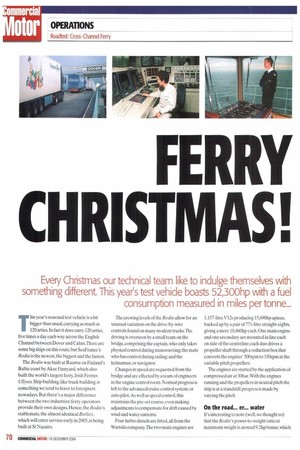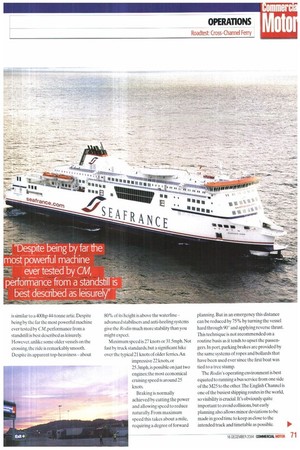FERRY CHRISTMAS!
Page 70

Page 71

Page 72

Page 73

Page 74

If you've noticed an error in this article please click here to report it so we can fix it.
Every Christmas our technical team like to indulge themselves with something different This years test vehicle boasts 52,300hp with a fuel consumption measured in miles per tonne...
This year's seasonal test vehicle is a bit bigger than usual, carrying as much as 120 artics. In fact it does carry 120 artics, five times a day each way across the English Channel between Dover and Calais.There are some big ships on this route, but SeaFrance's Rodin is the newest, the biggest and the fastest.
The Rodin was built at Raumu on Finland's Baltic coast by Aker Finnyard, which also built the world's largest ferry, Irish Ferries Ullyses. Shipbuilding, like truck building, is something we tend to leave to foreigners nowadays. But there's a major difference between the two industries: ferry operators provide their own designs. Hence, the Rodin's stablemate, the almost identical Berlioz. which will enter service early in 2005, is being built at St Nazaire. The crewing levels of the Rodin allow for an unusual variation on the drive-by-wire controls found on many modern trucks. The driving is overseen by a small team on the bridge, comprising the captain, who only takes physical control during manoeuvring; the mate who has control during sailing; and the helmsman, or navigator.
Changes in speed are requested from the bridge and are effected by a team of engineers in the engine control room. Normal progress is left to the advanced cruise control system, or auto pilot. As well as speed control, this maintains the pre-set course, even making adjustments to compensate for drift caused by wind and water currents.
Four turbo-diesels are fitted, all from the Wartsila company. The two main engines are 1,157-litre V12s producing 15,690hp apiece, backed up by a pair of 771-litre straight-eights, giving a mere 10,460hp each.One main engine and one secondary are mounted in line each on side of the centreline; each duo drives a propeller shaft through a reduction box that converts the engines' 500rpm to 150rpm at the variable pitch propellers.
The engines are started by the application of compressed air at 30bar.With the engines running and the propellers in neutral pitch the ship is at a standstill; progress is made by varying the pitch.
On the road... er... water
It's interesting to note (well, we thought so) that the Rodin's power-to-weight ratio at maximum weight is around 9.2hp/tonne, which is similarsimilar to a 400hp 44-tonne artic. Despite being by the far the most powerful machine ever tested by CM,performance from a standstill is best described as leisurely. However, unlike some older vessels on the crossing, the ride is remarkably smooth. Despite its apparent top-heaviness— about 80% of its height is above the waterline — advanced stabilisers and anti-heeling systems give the Rodin much more stability than you might expect.
Maximum speed is 27 knots or 31.5mph. Not fast by truck standards, but a significant hike over the typical 21 knots of older ferries.An impressive 22 knots, or 25.3mph. is possible on just two engines; the most economical cruising speed is around 25 knots.
Braking is normally achieved by cutting the power and allowing speed to reduce naturally. From maximum speed this takes about a mile, requiring a degree of forward planning. But in an emergency this distance can be reduced by 75% by turning the vessel hard through 90° and applying reverse thrust. This technique is not recommended on a routine basis as it tends to upset the passengers. In port, parking brakes are provided by the same systems of ropes and bollards that have been used ever since the first boat was tied to a tree stump.
The Rodin 's operating environment is best equated to running a bus service from one side of the M25 to the other:The English Channel is one of the busiest shipping routes in the world, so visibility is crucial. It's obviously quite important to avoid collisions, but early planning also allows minor deviations to be made in good time to keep as close to the intended track and timetable as possible. The bridge spans the whole width of the front of the ship, with extensions at each side giving a near 360° field of view.These extensions include duplicated driving controls for manoeuvring in dock — they even have glazed floor panels to allow a view directly downwards, which (disconcertingly, in our case) means 25m straight down to the water while at sea.This view is okay in fine weather, but this is not something the Channel is renowned for. Four separate radar systems, including two dedicated to collision avoidance, provide the view when mere human eyesight is no longer adequate.
Productivity
In many ways, the Rodin 's running costs impact directly on those of its customers.The less it costs to run the ship, the more competitive the prices available to operators. At about 70 tonnes of heavy oil per day, the overall fuel consumption for five return crossings works out at around 3.57 miles/tonne.This may not sound too impressive, but actually reflects a significant improvement compared with the older vessels in the fleet.
More important is the payload. Like certain truck operations, ferries tend to cube out before the weight limit is reached.The Rodin is primarily a freight ferry, and its two main decks combine to give a total of 2,000 lane/metres (the lanes are 3.1m wide and 4.9m high).That's enough for 120 artics.The outside space at the front of the ship is reserved for up to six trucks carrying hazardous materials.Tourist traffic is also catered for, with another 470 lane/mctres available on suspended platforms providing space for about 95 cars.
All this capacity is no use if the ship is tied up in the dock in poor weather. The Rodin's powerful transverse thrusters allow it to dock in winds of up to 50mph without the aid of tugs. In practice, however, problems with manoeu vring less powerful ferries would mean that Dover's harbour would be closed some time before this level of weather was reached.
The big advantages of all those engines is that the Rodin can operate quite happily on any two, preventing the need to park up for running repairs, which can be carried out at sea.The only major downtime is an annual service which takes three weeks.
Residual value figures aren't covered by either of the leading price guides. Due to its specialist design there's a limited used market for this type of vessel. Only a few routes around the Greek islands need a high degree of manoeuvrability in shallow waters so they tend to stay with their original operators throughout their 25-year design life, after which they may only have scrap value.
Cab comfort Unusually for CM test vehicles, the accommodation on board the Rodin is geared more towards the passengers than the driver.At over 100 metres long and 28 metres wide, the Rodin's accommodation has seating for 1,900 passengers — that's enough to cope if all the vehicle decks are filled with cars, each with four occupants.
This being a freight ferry, the most important area is "le Driver's Restaurant" where drivers can meet up and chat over a meal.The decor has an American-diner' theme and the walls feature paintings of 1950s trucks, cars and music legends. It's bright, spacious and airy. with room for 160 drivers, who can eat as much they like for £4.75 including a starter, main course, dessert and drink.
There's a wide choice of predominantly French-style dishes on offer, ranging from boeuf bourguignon to traditional English fish and chips, with a tempting (okay,irresistible) selection of gateaux and French pastries.
The freight drivers' area features a number of toilets and showers; if drivers have taken their families along on the trip they can deposit the kids in the well-equipped video games area.
Even with its full complement of freight traffic the Rodin has plenty of space in the tourist areas. "Le Bar" is based on an English pub, serving a range of wine, beers and spirits. Here the driver can enjoy the crossing in tranquil surroundings and the comfort of big sofas.
Those fancying a more Continental offering can enjoy the benefits of "le Parisian cafe" with a traditional petit dejeuner of croissants and black coffee and the view through the huge windows. For more substantial meals there's "Le Relais" self-service, serving the same meals as the freight drivers, but without the subsidy, or the 60-seat silver-service "La Brasserie" restaurant.
No cross-Channel journey would be complete without the obligatory retail opportunity, and the Rodin 's shop stocks everything from the traditional fags 'n' booze to newspapers and perfume or, in our case, just a bar of Toblerone for the folks back in the office (and a very small bar it was too — Ed). On such a short route the only sleeping accommodation is the cabins for 85 crew and 15 officers.
All these people need taking care of, and modern ferry safety standards are reassuringly high. A CCTV system allows the crew to monitor the vehicle decks at all times; lifeboats and chute-loaded liferafts have a combined capacity of over 2,500. For smaller scale emergencies, the Rodin's roof incorporates a helipad.All aspects of the ship's operation are monitored by a data recording system. um


















































































































































































































